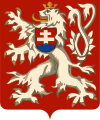Czechoslovakia–Norway relations
 | |
Czechoslovakia |
Norway |
|---|---|
Czechoslovakia–Norway relations refers to the foreign relations between Norway and the now-defunct state Czechoslovakia.
Up to World War I
Norway was an independent country since 1905, at the

The Norwegian poet, playwright and political agitator
Interwar period
Both countries were founding
On 11 March 1937 in Oslo, Czechoslovakia and Norway signed a cultural cooperation treaty. The people who closed the agreement include Emil Franke, Halvdan Koht and Nils Hjelmtveit. According to Hjelmtveit, it was the first treaty of its kind signed by Norway. Olav Rytter was the main translator at the negotiations and signing. The first large result of the treaty was an exhibition of Czech and Slovak books at the Norwegian Museum of Decorative Arts and Design in April 1938. A planned Norwegian exhibition in Prague in the autumn of 1938 was not held because of the events surrounding the Munich Agreement.[5]
World War II

Czechoslovakia was
During the war, the two exiled governments were headquartered in London. On 8 December every year, the birthday of Bjørnstjerne Bjørnson, the two governments held Czechoslovakia–Norwegian festivities, in spirit of the cultural cooperation treaty.[5] Olav Rytter was stationed in London as well. He made a career as a Slavic philologist, and after the war he served from 1948 to 1953 as Director of the United Nations Information Office in Prague.[6]
Cold War
The
During the Cold War, the Czechoslovak intelligence
Cold War cultural exchange
Norwegian
The
Norwegians who were decorated for contributions to Czechoslovak culture include Kjell Bækkelund, who received the Janáček Medal.[16]
See also
References
- ^ Hannevik, Arne. "Bjørnstjerne Bjørnson". In Helle, Knut (ed.). Norsk biografisk leksikon (in Norwegian). Oslo: Kunnskapsforlaget. Retrieved 24 October 2010.
- ^ Hoem, Edvard. "Bjørnstjerne Bjørnson. The dissolution of the Norw.-Swedish union and his support to the Slovakian liberation movement". Archived from the original on 24 July 2011. Retrieved 24 October 2010.
- ^ Brøymer, Bjørn (21 October 2010). "Får norsk kongebesøk for første gang". Aftenposten/Adresseavisen (in Norwegian). Retrieved 24 October 2010.
- ^ Maps of Björnsonova in Bratislava Archived 2011-08-20 at the Wayback Machine, Prešov Archived 2011-08-20 at the Wayback Machine and Nové Zámky Archived 2011-08-20 at the Wayback Machine by mapa.megaportal.sk. Retrieved 24 October 2010.
- ^ a b Hjelmtveit, Nils (1969). Vekstår og vargtid (in Norwegian). Oslo: Aschehoug. pp. 62–63.
- ^ Dahl, Hans Fredrik. "Olav Rytter". In Helle, Knut (ed.). Norsk biografisk leksikon (in Norwegian). Oslo: Kunnskapsforlaget. Retrieved 24 October 2010.
- ISBN 0-7656-1017-5.
- ^ Titlestad, Torgrim. "The Cold War in Norwegian Politics". The Communist Chronicles. Retrieved 24 October 2010. (originally printed in Syn og Segn 1989
- ^ Tretvoll, Halvor Finess (2 February 2010). "Det ukjente spionspillet". Dagsavisen (in Norwegian). Archived from the original on 26 February 2011. Retrieved 24 October 2010.
- ISBN 978-82-03-29188-3.
- ^ Englund, Terje B. (23 March 2005). "En norsk spiontragedie". Aftenposten (in Norwegian).
- ^ Jonassen, Arild M. (29 March 2005). "Mange norske spioner". Aftenposten (in Norwegian).
- ^ Helgesen, Anne (11 February 2010). "Birgit Strøm ble dobbelt overvåket". Dagbladet. p. 35.
- ^ "Den vesle heksa" (in Norwegian). barnetvmimring.com. Archived from the original on 2 October 2010. Retrieved 24 October 2010.
- ^ Stephan, Mari-Louise U. "Fortellerstemmen bak Askepott". Studvest (in Norwegian). Archived from the original on 24 July 2011. Retrieved 24 October 2010.
- ^ Andersen, Rune J. "Kjell Bækkelund". In Helle, Knut (ed.). Norsk biografisk leksikon (in Norwegian). Oslo: Kunnskapsforlaget. Retrieved 22 February 2011.


